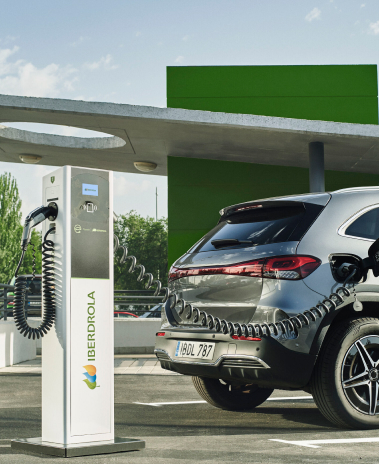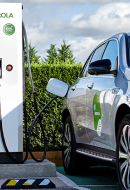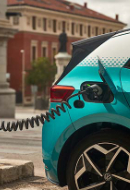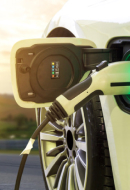Difference between plug-in hybrid and electric
Electric car or plug-in hybrid? We tell you the main differences between these mobility solutions.
Decarbonisation of the economy and sustainable mobility go hand in hand. Electric vehicles and plug-in hybrids play a key role in this process and are becoming increasingly popular in cities. Technological improvements support these solutions, which will gradually displace other polluting alternatives such as pure combustion engines.


What is an electric car?
An electric car is a vehicle powered by one or more electric motors. These motors are powered by a source of electrical energy, which will be transformed into the kinetic energy necessary for the movement of the whole.
Electric vehicles can be charged, or not, via the electricity grid through public charging points, or through private charging points in private homes, for example.
The necessary electrical energy is stored in batteries. The most widespread technology in this area is lithium-ion batteries, although there is research exploring other possibilities. You can explore everything you need to know about electric car batteries on this page.
The history of the electric car is long and fruitful. Today, they have become a real alternative to other more polluting and less sustainable modes of transport.
They are vehicles with lower maintenance costs, as they have fewer mechanical parts, and have lower charging costs than combustion vehicles. Electric cars measure consumption in kWh per 100 km, so the price of charging will depend on the price per kWh. For example, if the price is set at €0.25 per kWh and we have to charge a 50-kWh battery, the charging cost will be €12.50.
These prices depend on the cost per kWh at the charging point, the type of charging (standard, fast or ultra-fast) and the capacity of the battery, of course.
The range of electric cars may be one of their main barriers to entry, as it averages 16 kWh per 100 km (a car with a 77-kWh battery will have a theoretical range of about 480 km). Batteries are becoming longer and longer range and allow electric cars to cover more distance without needing to charge during the journey.
On the other hand, in many countries, this type of vehicle benefits from purchase subsidies and tax advantages, both for individuals and companies. For example, in some places, they are exempt from registration tax, or they benefit from reductions in road tax. In Spain, for example, there is the MOVES Plan, which provides grants of up to €4,500 for the purchase of new vehicles.
Finally, they are vehicles that enjoy mobility advantages as they are authorised to enter areas restricted to polluting vehicles in large urban centres (in Spain they fall into the category of the DGT's Zero Emissions Environmental Distinction). These low-emission zones are becoming increasingly popular, which means that the electric alternative is gaining ground in this type of urban context.
Advantages of electric cars
Every day there are more and more electric cars on our roads, in our cities and towns. But what are their main advantages?
Source: Massachusetts Clean Energy Center, U.S. Department of Energy.
What is a plug-in hybrid car?
A plug-in hybrid car is a hybrid car with a larger battery than the non-plug-in hybrid car, which is capable of operating in pure electric mode over a medium range of distances.
Hybrid vehicles are, by definition, vehicles that combine two powertrains: an internal combustion engine and a battery-powered electric motor. This simple definition can be broadened depending on the arrangement of the engines (series or parallel) and other considerations. But, taking the discussion to plug-in hybrid cars, they are an evolution of hybrids with a higher capacity battery, which is charged by plugging it into the mains.
These batteries allow plug-in vehicles to operate in 100% electric mode for medium distances (currently 80-100 km).
The battery of the plug-in hybrid car can be charged in several possible ways:
- While the combustion engine is running, the electric battery is slowly charged.
- Through what is known as regenerative braking. When the brakes are applied, some of the energy dissipated as heat is converted into electrical energy. This is known as kinetic energy recovery and you may be familiar with the acronym KERS.
- By plugging it into the mains, either at a public or domestic charging point.
Although they do not achieve zero emissions, plug-in hybrid cars achieve a very significant reduction in emissions compared to internal combustion engine cars.

What is electric mobility?
What electric mobility is, its history and its contribution to the energy transition.

Advantages of the electric car
Why should I buy an electric car?

History of the electric car
Discover the journey of more than 200 years of the electric car, from its origins to today.

Electric car batteries
Learn everything you need to know about electric car batteries.
The electric car is the future
Of all the alternative propulsion vehicle options, the electric car has the greatest long-term potential to help in the fight against climate change, aid the decarbonisation of mobility and make urban environments more friendly for their inhabitants.
An electric vehicle has a very positive impact on noise pollution, reducing it considerably and contributing to making urban environments more liveable. In addition, they do not emit polluting gases when they run and, if the electric energy comes from renewable sources, their environmental impact is even lower.
Electric car batteries are the subject of ongoing research, both in terms of materials and storage technology. In this way, at the same time as research is being carried out into lighter, higher capacity batteries, progress is being made on issues as crucial for the environment as the recycling of these devices, which is currently a battle horse for all manufacturers.
Iberdrola's commitment is clear: electric mobility is the future, and to this end it is working on more and better networks of charging points, as well as on the generation of more clean energy.












